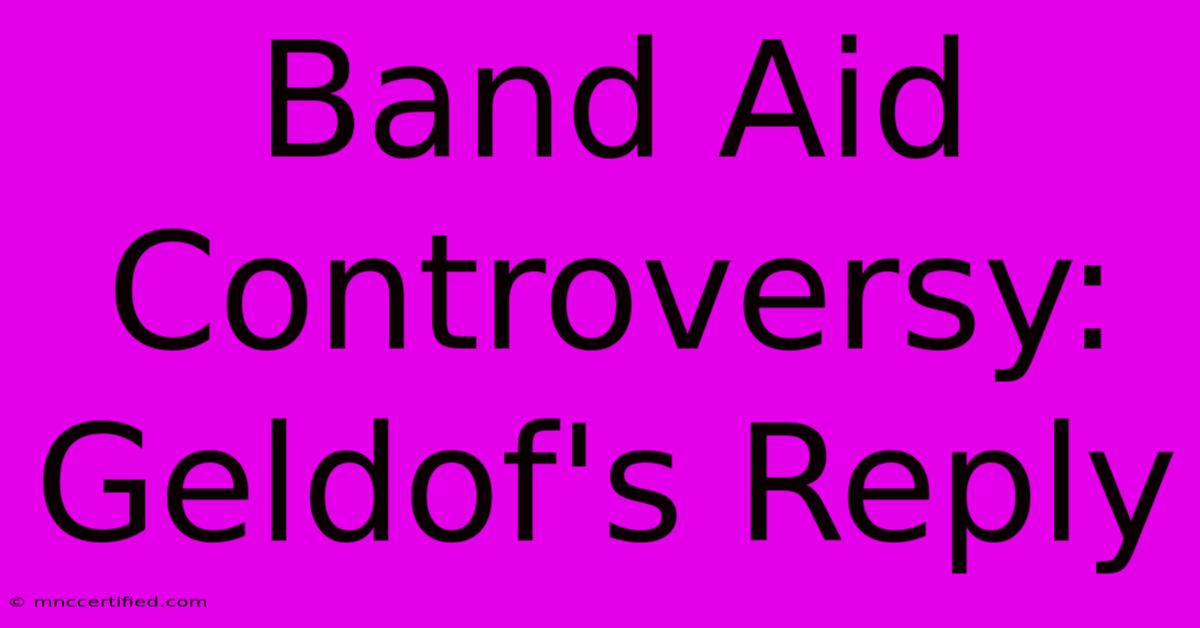Band Aid Controversy: Geldof's Reply

Table of Contents
Band Aid Controversy: Geldof's Reply – A Look Back at the Fallout
Bob Geldof's Band Aid, conceived as a swift response to the Ethiopian famine, became a cultural phenomenon. However, the project wasn't without its controversies, sparking heated debates that continue to resonate today. This article delves into the key criticisms leveled against Band Aid and examines Geldof's responses, offering a nuanced perspective on this complex legacy.
The Criticisms: More Than Just a Misplaced Microphone
While the charitable intentions of Band Aid were undeniable, several criticisms emerged, challenging its effectiveness and methods. These included:
1. Ineffective Aid Distribution:
A major point of contention centered around the efficiency of aid distribution. Critics argued that much of the money raised wasn't effectively reaching those in need, highlighting bureaucratic inefficiencies and corruption within the aid organizations involved. The lack of transparency in the disbursement process fuelled accusations of mismanagement.
2. The "Paternalistic" Approach:
The portrayal of Africa as a monolithic, helpless entity needing Western salvation was widely criticized as paternalistic and neo-colonial. Critics argued that the campaign perpetuated harmful stereotypes, ignoring the complex political and economic factors contributing to the famine. The imagery used in the video and promotional materials was often flagged as reinforcing these problematic narratives.
3. The "We Are the World" Effect and its Limitations:
While undeniably successful in raising awareness and funds, the "We Are the World" approach, replicated in many charity singles, was criticized for its simplicity. The focus on charitable giving, as opposed to addressing the root causes of poverty and famine, was seen by some as a way of deflecting attention from the complex issues at play, including global trade policies and political instability.
Geldof's Defense: A Complex Legacy
Geldof, initially lauded as a humanitarian hero, faced these criticisms head-on, often with a robust and sometimes defensive posture. His responses, while partially addressing concerns, also revealed a complex and multifaceted character.
1. Addressing Aid Inefficiency:
Geldof consistently defended the overall amount of aid raised, emphasizing the scale of the crisis and the unprecedented level of public engagement Band Aid generated. He acknowledged challenges in aid distribution, but attributed many issues to the chaotic realities on the ground, rather than inherent flaws in the project's design.
2. Responding to Accusations of Paternalism:
While never fully conceding to the accusations of paternalism, Geldof often stressed the urgency of the situation, arguing that immediate action was necessary to save lives, even if the underlying issues required long-term solutions. He also highlighted the significant amount of money raised, positioning it as a tangible outcome that superseded critiques of its messaging.
3. The Justification of the "We Are the World" Approach:
Geldof's defense of the "We Are the World" approach often centered on its immediate impact. He argued that it successfully galvanised global support and raised substantial funds, a pragmatic outcome that justified the simplicity of the message. He acknowledged the limitations of such a method but insisted it played a crucial role in raising awareness.
The Lasting Impact and Ongoing Debate
The Band Aid controversy remains a relevant and complex discussion, highlighting the inherent challenges in large-scale humanitarian efforts. While the project undeniably generated significant funds and awareness, the debate around its methods and messaging underscores the need for critical examination of charitable initiatives. Analyzing Geldof's responses reveals a struggle between the urgency of immediate action and the complexities of long-term solutions to systemic issues. The legacy of Band Aid continues to provoke discussion about the ethical considerations, practical challenges, and lasting impact of large-scale charity projects. This nuanced perspective helps us understand the lasting impact of such initiatives and encourages more thoughtful approaches to future humanitarian work. The controversy itself serves as a valuable case study for understanding the complexities of international aid and the ongoing debate around development and global justice.

Thank you for visiting our website wich cover about Band Aid Controversy: Geldof's Reply. We hope the information provided has been useful to you. Feel free to contact us if you have any questions or need further assistance. See you next time and dont miss to bookmark.
Featured Posts
-
Premier Choice Dental Insurance
Nov 26, 2024
-
Menendez Brothers Resentencing Update
Nov 26, 2024
-
Possible D B Cooper Parachute Found
Nov 26, 2024
-
Jon Benet Director Believes In Solution
Nov 26, 2024
-
Punchbowl Investment Party City
Nov 26, 2024